2022 Chocolate/Raspberry Port in Detail
Last updated 12/04/2022
I’m in the mood to make another detailed dive into a wine — this one a port-style dessert wine.
The other day I spotted that I was down to fifteen bottles each of my Coffee Port and Black Forest Port, and had the urge to make another. I’ve wanted a chocolate raspberry, and guess what??? American Brewmaster had one in stock!
This kit is different enough from the previous “in detail” posts that I’ll do a deep dive into it.
Menu (Dates of Activity)
| 03/14/2022 | 03/21/2022 |
| 03/15/2022 | 03/27/2022 |
| 03/17/2022 | 03/31/2022 |
| 03/18/2022 | 10/15/2022 |
03/14/2022
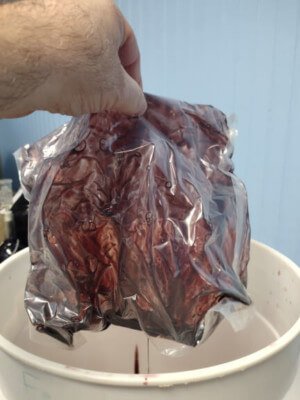
Up front, this kit is not exciting to start. Per usual, I dissolved bentonite into hot water, added the concentrate bag, rinsed it (adding the water to the fermenter), and topped to 3 US gallons.
Where this kit is different is step feeding — there is a sugar packet (400 g) that I will add when the initial ferment is nearly done.
The kit includes two packets of Lalvin EC-1118 yeast, and it uses both. This is a workhorse yeast that will ferment a rock if given the opportunity. EC-1118 is also high potency, which is necessary as this kit ends in the 17-18% ABV range, and a lot of yeasts cannot handle that.
I’m a bit disappointed, as the SG read 1.111 whereas the instructions say the OG should be in the 1.119 to 1.124 range. We’ll see what it reads tomorrow.
But I went in a different direction. I made a starter using 2 tsp Avante yeast (I have half a pound left!), 1/2 tsp Fermax nutrient, and 1 tsp sugar. I’m going to ferment the wine down to below 1.020, make a starter with a packet of EC-1118, and add it along with the sugar packet. I figure this will work.
03/15/2022
I checked the SG in the evening when working on the Elderberry. The SG did rise, but only to 1.116. Oh well, I’m not concerned. It’s close enough and it may be that I added a bit more water than the instructions called for.
So I added the yeast starter.
03/17/2022
I have a problem — as with the Elderberry, there is no activity — the starter failed.
All is not lost. It’s simply a matter of making another starter.
I’m fairly sure the problem was my storage conditions for the yeast, as I kept it in the freezer. That was the recommendation from years ago, although recently yeast vendors are saying to refrigerate, not freeze.
The yeast went from the freezer (0 F) to room temperature water (72 F) to my cellar (~65 F). Although the starter appeared to be working, my guess is that it wasn’t vigorous enough to make a go of it in the must.
I considered going with EC-1118, but since I have over half a pound of Avante, I’ll give it another try. If it doesn’t take off well, then I’ll go with the EC-1118.
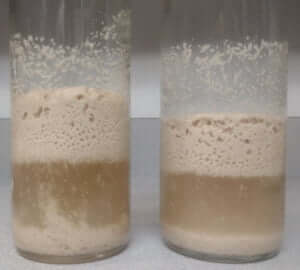
First, I heated water to 100 F, then added a splash of cold water and stirred. The result was 93 F, which is a good temperature for yeast, even if it’s too hot for wine. Once the starter is going, it will cool to room temperature.
To a sanitized wine bottle I added 4 tsp Avante (yes, I went heavy!), 1/2 tsp Fermax, and 1/2 tsp sugar, then 1 cup water. I swirled to mix. The intention is to ensure I have a large colony of yeast going.
Note: I made 2 starters, as the Elderberry also failed to start.
Within 15 minutes the starter was foaming hard and the water churned with activity. I let the bottles set on the kitchen counter for 6 hours, during which time they cools to room temperature (72 F), then spent 2 hours on the wine counter (65 F). After that I inoculated.
03/18/2022
We have full ignition!
This one has shredded oak skidding around on the surface as CO2 pushes it around. The SG has dropped over 20 points in 24 hours.
This is more than double the Elderberry’s SG drop, which was inoculated at the same time. Why the difference? Batch size — this one is 3 gallons while the Elderberry is 7 gallons, so while growing and eating at the same rate, the volume difference produces a different SG. Once the yeast reproduces to its max, the rate change will equalize.
03/21/2022
The SG dropped to 1.018, so it’s time to add the chaptalization sugar. I stirred in the 400 g packet, and the SG jumped to 1.030.
While the Avante yeast is supposed to have an alcohol tolerance of 17%, this wine will go to about 18%. So I created a starter using EC-1118, 1/2 tsp Fermax, and 1/2 tsp sugar. I’ll add that tomorrow morning.
03/27/2022
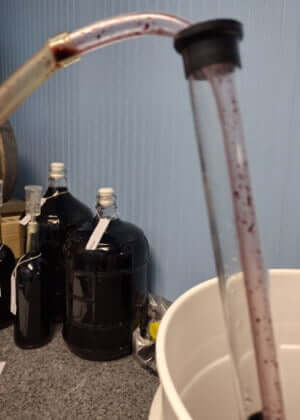 This afternoon the SG is 0.998. I checked the instructions, and it said to continue any time the SG dropped below 1.010.
This afternoon the SG is 0.998. I checked the instructions, and it said to continue any time the SG dropped below 1.010.
WOW! That surprised me, as I figured the plan would be to ferment dry.
Well, 0.998 is dry. I tasted a tiny sample, and of course it’s a bit fizzy and acidic from the trapped CO2. But it tasted dry — I didn’t get any sugar, so it’s probably close.
I racked the wine into a sanitized 19 liter carboy, which is what I’m using for this next stage. It’s an interim destination, not the final. During this process I reserved wine in 2 sanitized wine glasses.
Also note that I when I rack, I hold the cane off the bottom, and when the wine gets low I tilt the fermenter. I racked so that I lost only milliliters of wine, and started sucking up sediment. Once that happened I pulled the cane up to stop the siphon. Sure, some sediment went into the carboy, but it settled once, it will settle again. The wine tossed down the drain is gone forever.
The instructions say:
- Add sorbate/K-meta pack. Stir for 10 minutes, or 2 to 4 minutes with a powered stirring rod.
- Stir in kieselsol.
- Next day: Pour into a clean container. Reserve 1 liter wine. Add F-pack. Stir in chitosan. Top with reserved wine.
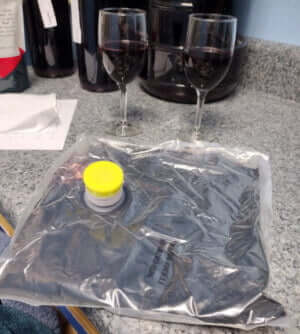
The instructions are garbled and don’t make sense, so I went a slightly different route.
Regarding kieselsol and chitosan — the kieselsol is added first. I have seen instructions that state the chitosan should be added 2 minutes later, 5 minutes later, 1 hour later, and 24 hours later. My experience says that adding 2 minutes later works. Finer Wine Kits says to add them together, and my opinion of Matteo Lahmer (owner) is that I trust his opinions, so I see no point in waiting a day.
So I did everything in about 10 minutes:
- Added the F-Pack, which smells VERY good — chocolate and raspberry! I poured one of the reserved glasses of wine into the F-Pack bag, put the cap back on, and shook it to loosen any remaining liquid in the bag, and added it to the carboy. Then I repeated this with the second glass — I want every bit of flavoring there is!
- Sanitized my drill-mounted stirring rod and stirred the wine for 30 seconds, switched directions and stirred again. The SG rose t0 1.015.
- Added the sorbate/K-meta packet and the kieselsol, and stirred for 30 seconds.
- Waited 2 minutes, added the chitosan, and stirred again for 30 seconds.
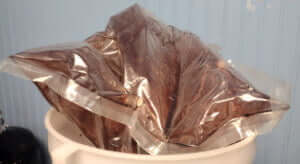 Finally I sealed the carboy with a drilled stopper and airlock. I shook the carboy hard and the air bubbled rapidly through the airlock, indicating a lot of remaining trapped CO2.
Finally I sealed the carboy with a drilled stopper and airlock. I shook the carboy hard and the air bubbled rapidly through the airlock, indicating a lot of remaining trapped CO2.
I will ignore the wine for 7 to 10 days, then rack off the sediment. At this point the wine will go into a 3 gallon carboy for bulk aging.
03/31/2022
I’m going to be busy over the weekend and through next week, so I decided to rack today. Yeah, it’s only been 4 days, but with K&C, most of the sediment drops in the first day and the wine is in a 19 liter carboy. The excessive headspace concerns me. While wine is degassing it means a lot less, but I’ve learned to be cautious.
Normally I’d not rack this quickly, but I had the wine in a 19 liter carboy while degassing and needed to get it out due to excessive headspace. My guess is 95% of the sediment has dropped, so what’s left is fine lees, which is OK to leave in.
I racked the wine, adding 1/4 tsp K-meta. That’s a bit heavy for 3 gallons, but I’m not concerned, as it will be far less than the legal amount.
Unfortunately, the carboy was not quite full after the racking. I was drinking Rioja, looked at the bottle, thought about it for a moment, then topped with 4 oz. Those 4 oz of wine in 3 gallons will not be noticed. I could use Concord and it would not be noticed. Having the wine oxidize during bulk aging due to excessive headspace? THAT will be noticed.
The SG dropped a bit, from 1.015 to 1.012, which indicates the stirring of the F-pack was not sufficient. This seems to be a common issue. I’m less and less trusting of the SG after stirring. The following day is probably more accurate.
10/15/2022
Racked the wine, added 1/4 tsp K-meta (as I had not added during bulk aging), and 3 oz glycerin.
I noted the SG had risen a couple of points. When first adding the F-pack, the SG was 1.015. Four days later it was 1.012, which I attributed to melding. At bottling it was 1.014 (before adding glycerin). This makes me really question how effective stirring really is.
I netted 30 split (375 ml) bottles.
